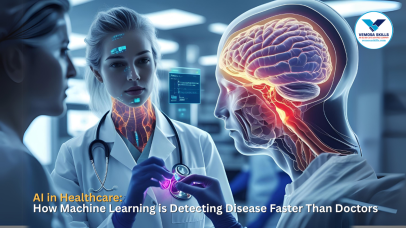AI in Healthcare: How Machine Learning is Detecting Disease Faster Than Doctors
As you know, AI is revolutionizing every type of industry in the world and one of them is healthcare. Among these AI applications, machine learning is a method that is known for its ability to detect diseases faster, more accurately and often earlier than other traditional diagnostic methods. It is way ahead of its time. From early detection of serious diseases like cancer to identifying rare diseases, AI based algorithms are reshaping the way we diagnose and treat.
Today in this blog, we will know how machine learning is bringing a big change in healthcare and what are the real-world applications that are already working and how this change is not only improving diagnosis but also potentially saving millions of lives.
What Is Machine Learning in Healthcare?
Machine learning is a subset of AI where a computer is trained to learn from data and think intelligently, make decisions and make predictions. In healthcare, machine learning analyzes huge amounts of medical data – including laboratory tests, medical images, genetic data and patient records. It identifies patterns that indicate a disease.
While our doctors are exhausted from their work, it takes time and cognitive load to diagnose any disease, machine learning algorithms can diagnose any disease by analysing millions of data points in just a few seconds.
Why is timely detection so important?
For us humans, timely detection of any disease is the difference between life and death – 2 minutes late here and there, the person dies. You know how diseases like cancer, Alzheimer’s and heart disease grow silently and as they grow, it becomes more difficult for us to treat them. So it is clear that the sooner a disease is detected and diagnosed, the more effective the treatment and the better the patient outcome, which means our loved ones stay with us.
How machine learning is detecting diseases faster than doctors
1. Medical imaging and radiology
The most exciting area in healthcare where machine learning is outperforming traditional diagnosis is medical imaging. Here, machine learning shows its magic by detecting anomalies with remarkable accuracy with machine learning algorithms trained on thousands or even millions of x-rays, MRIs, CT scans and ultrasounds.
Example:
You may have seen that Google's DeepMind has developed an AI model that can detect more than 50 eye diseases from retinal scans, and that too with as much accuracy as a leading eye doctor. Similarly, AI systems like Lunit and PathAI are helping radiologists identify breast cancer, lung cancer and tuberculosis in imaging scans - often finding irregularities that the human eye cannot see.
2. Cancer detection and pathology
We all know how terrible cancer is and how it has taken so many lives. Whenever someone finds out that he has cancer, that person dies half out of fear. But now the chances of this are less because with the help of machine learning, we can analyze biopsy samples, detect tumor markers in the blood and predict the possibility of cancer before physical symptoms appear and start treatment as early as possible, which increases the patient's chances of survival.
Example:
IBM Watson for Oncology uses machine learning to recommend cancer treatments by analyzing medical literature, clinical trial data, and patient health records. Its predictive models significantly reduce the time for doctors to make optimal treatment decisions.
3. Predicting disease before symptoms appear
One of the most powerful capabilities of ML is predictive modeling. By analyzing a patient’s genetic profile, lifestyle, history, and environment, AI can forecast the likelihood of developing conditions such as diabetes, heart disease, and neurological disorders.
Example:
Stanford University developed a machine learning model that can predict heart attacks years in advance by analyzing EKG data. Similarly, Apple Watches use AI-powered algorithms to detect irregular heart rhythms, potentially warning users about atrial fibrillation before they feel any symptoms.
4. Electronic Health Record (EHR) Analysis
Electronic health records are a treasure trove of patient data, but they are often underutilized due to complexity and volume. Machine learning can mine these records to detect patterns that indicate early signs of diseases like sepsis or kidney failure.
Example:
The University of Chicago Medical Center partnered with Google to use ML to predict hospital readmissions and disease progression. Their model can predict a patient’s severe deterioration up to 48 hours in advance.
Benefits of Machine Learning in Healthcare Diagnostics
✅ Speed and Efficiency
ML can analyze data in seconds – much faster than any human – accelerating diagnosis and reducing the burden on healthcare professionals.
✅ Accuracy
AI does not suffer from fatigue or bias. It can detect subtle patterns invisible to the human eye, leading to high diagnostic accuracy.
✅ Scalability
Once trained, ML models can be deployed in thousands of hospitals, providing expert-level diagnosis, especially in resource-limited areas, remote or underserved regions.
✅ Cost-effectiveness
Faster, more accurate diagnoses reduce the need for expensive late-stage treatments and hospitalizations, potentially saving billions globally.
Challenges and Ethical Considerations
Despite its promise, AI in healthcare raises important questions:
1. Data Privacy
Medical data is sensitive. Ensuring patient privacy is a pressing issue when using large datasets for training ML models.
2. Bias and Inequality
If training data lacks diversity, ML models may underperform for certain demographics, leading to biased results.
3. Regulatory Hurdles
AI tools must undergo rigorous clinical validation and regulatory approval before widespread use.
4. Doctor-AI Collaboration
AI is a tool — not a replacement. It should support physicians, not replace them. Proper integration into the clinical workflow is essential.
AI vs. Doctors: Competition or Collaboration?
While machine learning can outperform doctors in speed and pattern recognition, it lacks empathy, contextual understanding, and human judgment. The best healthcare systems will combine human expertise with AI assistance, allowing doctors to focus on patient care while AI handles data-heavy diagnosis.
Imagine a future where:
- AI scans your test results overnight.
- Alerts doctors to early signs of disease.
- Suggests treatment options backed by global data.
Doctors can then make informed, empathetic decisions, which increases patient trust and satisfaction.
The Future of Disease Detection with AI
We’re just scratching the surface of AI’s potential in disease detection. Here’s what’s in the near future:
- Real-time disease monitoring using wearable devices.
- AI-powered personalized medicine tailored to your genetic code.
- Global disease surveillance for predicting pandemics.
- AI chatbots screening patients in virtual healthcare settings.
As AI technology evolves, it can also lead to proactive healthcare systems that stop diseases before they develop – the focus shifts from treatment to prevention.
Final Thoughts: Embracing the AI Revolution in Healthcare
The integration of machine learning into healthcare isn’t just a trend – it’s a paradigm shift. By detecting diseases faster than doctors, ML is giving us a powerful tool to fight disease, reduce costs and improve patient outcomes globally.
Still, it’s important to find a balance – leveraging AI’s capabilities while retaining the human touch that makes medicine compassionate and ethical. As we move forward, doctors and AI must work hand-in-hand, ensuring that healthcare is faster, fairer and more effective for all.
✅ Key points:
- AI and machine learning are transforming diagnostics in radiology, oncology and cardiology.
- Early detection is key – and ML can identify diseases before symptoms appear.
- Doctors are not being replaced, but rather empowered by AI to make better decisions.
- Ethical, fair and safe AI systems are key to long-term adoption.
- The future of healthcare is AI-assisted, personalised and prevention-focused.





